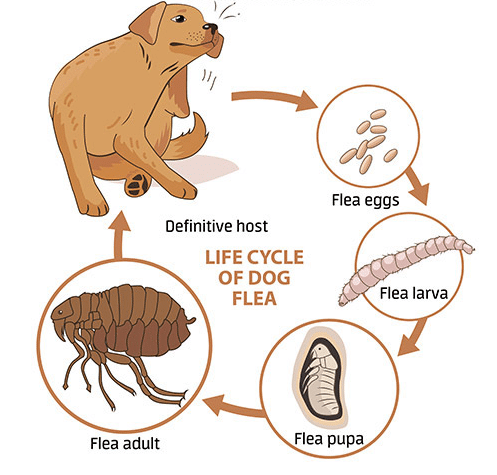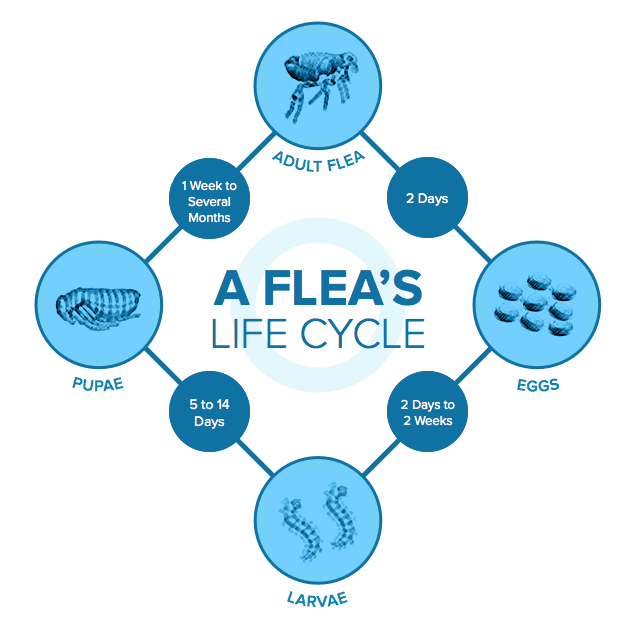What Do Flea Eggs Look Like
Flea Eggs: When it comes to eliminating fleas from your pet and from your home, there are some key things to consider. First, it is very important to be familiar with and understand the life cycle of the flea when you are trying to eradicate their presence completely.
There are four stages in the life cycle of a flea: egg, larva, pupa, and adult. Depending on the environmental temperature and humidity levels, the total life cycle will take anywhere from a couple of weeks to many months. Optimal conditions for fleas are between 70-85°F and 70 percent humidity.

What Do Flea Eggs Look Like
To hasten the elimination of fleas within the home, it may be desirable to treat the premises along with the pet. This is especially true with severe infestations when pets and people are suffering irritation from bites.
Before such treatment, the pet owner should:
- Remove all toys, clothing, and stored items from floors, under beds, and in closets. This step is essential so that all areas will be accessible for treatment.
- Remove pet food and water dishes, cover any fish tanks, and disconnect their aerators.
- Wash pet bedding.
- VACUUM. Vacuuming removes many of the eggs, larvae, and pupae developing within the home. Vacuuming also stimulates fleas to emerge sooner from their insecticide-resistant cocoons, thus hastening their exposure to treatments. By raising the carpet nap, vacuuming improves the insecticide’s penetration down to the base of the carpet fibers where developing fleas live. Vacuum thoroughly, especially areas where pets rest or sleep. Don’t forget to vacuum along the edges of rooms and beneath furniture, cushions, beds, and throw rugs. After vacuuming, seal the vacuum bag in a garbage bag and discard it in an outdoor trash container.
Insecticide Application
Always read and follow instructions on the container. Many different products are available for home flea treatment. The most effective ones contain ingredients such as permethrin, imidacloprid, or dinotefuran that are lethal to the biting adult stage, and an “insect growth regulator” (e.g., methoprene, pyriproxyfen) that halts the development of flea eggs and larvae. Householders will need to consult the “active ingredients” panel on the product label to determine if these are present. Popular consumer brands containing such ingredients include Raid Flea Killer Plus® and Ortho® Home Defense. Professional versions sold online include Precor 2000® Plus Premise Spray, PT Alpine® Flea Insecticide, PT Ultracide® Flea Insecticide, and Nyguard® Plus Flea and Tick Premise Spray. Most householders will find aerosols more convenient to use than liquids. Carpets and other surfaces treated with aerosols also tend to dry more quickly.
The application should be thorough and include all likely areas of flea development. Carpets, throw rugs, under and behind beds and furniture, and beneath sofa cushions on which pets sleep should all be treated. Pay particular attention to where pets spend much of their time. Since this is where most of the eggs, larvae, and pupae will be concentrated. For example, if the family cat sleeps on a chair or hides under a bed, these areas should be treated as well. Hardwood, tile, and concrete floors generally do not need to be treated but should be vacuumed. People and pets should remain off treated surfaces until the spray has dried. This may take a few hours depending on the carpet type, ventilation, and method of application.
Flea Eggs On Cats

The beginning of the life cycle occurs when an adult female flea lays eggs following a blood meal from the host (e.g., your pet). Blood is necessary for the adult flea to reproduce. These eggs are small, white objects (slightly smaller than a grain of sand) that are laid in the pet’s fur in bunches of about 20. A single adult female can lay about 40 eggs every day.
The eggs will fall off your pet as s/he moves, allowing them to be disbursed throughout the environment where your pet spends his or her time. Eggs represent about one-half (50 percent) of the entire flea population present in an average home.
Eggs take anywhere from two days to two weeks to develop, hatching when environmental conditions are just right for them. If temperatures are cold and dry, the eggs will take longer; if temperatures are warm and humidity levels are high, the eggs will hatch at a faster rate. Larvae then emerge as the next life stage.
Flea Larvae
The emerging larvae are blind and will avoid being out in the light. They develop over several weeks by eating pre-digested blood (known as flea “dirt”) that adult fleas pass, along with other organic debris in the environment.
In appearance, flea larvae can be up to ¼-inch long and are white (almost see-through) and legless. Larvae make up about 35 percent of the flea population in the average household. If conditions are favorable, the larvae will spin cocoons in about 5-20 days of hatching from their eggs. This leads to the next life stage, called the cocoon or pupae stage.
The pupae stage of the flea life cycle accounts for about 10 percent of the flea population in a home. This cocoon stage is the last developmental stage before the adult flea emerges. The cocoon protects the pupae for several days or weeks before the adult flea emerges. If environmental conditions are not right for emergence, the cocoon can protect the developing flea for months, and in some cases, years.
Cocoons have a sticky outer coating that allows them to hide deep in the carpeting and not be easily removed by light vacuuming or sweeping. The cocoon also serves to protect the developing adults from chemicals.
The adult flea will not emerge until the presence of a potential host is made obvious – by vibrations, rising levels of carbon dioxide, and body heat. This may be triggered by your pet walking by, or people moving in the house, alerting the flea to emerge from its cocoon to feed.
Adult Fleas
Once a flea has emerged from the cocoon, it will need to begin feeding on a host within a few hours. Shortly after the first meal, adult fleas will breed and begin laying eggs within a few days. Female fleas are not able to lay eggs until they obtain a blood meal.
New adult fleas have a flat-bodied appearance and are very small and dark in color. Once they have had a chance to feed off your pet, they will become larger and lighter in color, taking on the more recognizable flea shape. Adult fleas account for less than 5 percent of the entire flea population in a home. They spend the majority of their time living on the host while they feed, breed, and lay eggs, and can live anywhere from a couple of weeks to several months on the host animal.
Flea Eggs On Dogs
Ridding your home of fleas can be a daunting and costly endeavor. Unlike most household pests, fleas bite dogs and cats as well as people. The bites can cause intense itching and irritation, and a hypersensitive animal will often require veterinary assistance. Fleas can also transmit tapeworms and bacterial infections. The pests are highly prolific — the biting adult stage might be living on the pet, in addition to hundreds or thousands of eggs, larvae, and pupae elsewhere in the home or yard. If early signs of fleas are ignored, infestations can quickly spiral out of control.
Flea eradication requires treatment of pets, and oftentimes the premises. Your level of success will depend on how these treatments. This publication will help you eliminate your flea problem and reduce the risk of future infestation.
Fleas are common external parasites of both dogs and cats. The adults are ravenous blood-feeders, consuming up to 15 times their body weight in blood per day. Pets initially become infested when adult fleas occurring indoors or outdoors jump on the animal. With the ability to jump vertically up to about 6 inches, the adults can easily hitch a ride onto a passing dog or cat, or even the shoes and pant legs of a human. Pets acquire fleas from kennels, groomers, etc., or from stray dogs, cats, or wildlife (especially opossums and raccoons) wandering through the yard. Contrary to popular belief, fleas seldom jump directly from one pet to another.
Flea Eggs On Cat
Adult fleas spend most of their time on the dog or cat, not on the carpet. This is why the treatment of the pet is an essential step in ridding a home of fleas. Within minutes of jumping on board, fleas begin to feed. Digested blood expelled as feces appears as dark, pepper-like specs in the pet’s fur. Mating and subsequent egg-laying occur within 24 hours. All of the eggs (40-50 per day) are laid in the fur. However, the eggs soon fall off into carpeting, beneath the cushions of furniture, and wherever else the pet rests, sleeps, or spends time. When treating premises, thorough attention to these areas is crucial.
After hatching, the eggs develop into tiny, worm-like larvae that remain hidden beneath carpet fibers, furniture cushions, and other protected areas. The larvae feed mainly on the feces (dried blood) expelled by the adults which accumulate, along with the eggs, in areas where pets tend to rest or spend time. Before becoming adult fleas, larvae transform into pupae within a silk-like cocoon surrounded by bits of debris. Pupae remain inside the cocoon for 1 to 4 weeks. However, it might take longer for them to emerge if conditions become unfavorable. For example when a flea-infested home becomes vacant.
The cocoon is also impervious to insecticides—another reason some fleas may persist for an extended period, even after the pet and home are treated.
The traditional approach for battling fleas typically involved concurrent treatment of both the pet and the premises. Revolutionary new products for eliminating fleas on pets have led to rethinking this long-held approach.
Products for treating dogs and cats are available in the form of oral medications and topical “spot-on” solutions, as well as sprays, collars, and shampoos. Be sure to read the product label to ensure you are purchasing the correct formulation and dosage for your pet. Some flea products should not be used on cats, while others are not approved for puppies and kittens. Some flea treatments also control ticks and internal parasites such as heartworms.
It is usually prudent to consult a veterinarian for the most appropriate treatment for your pet.
Veterinarians also tend to know which products are performing well in their particular locale. Products that worked well in the past may be less effective due to flea populations developing resistance to the insecticide—similar to how bacteria become resistant to some antibiotics. Never treat pets with the same products used to treat carpeting or the yard.
The most effective flea medications today tend to be in the form of oral/chewable tablets or topically applied liquids known as spot-on. Different dosages are available based on the weight of the animal.
Topical Solutions (Spot-on)
This form of treatment involves applying a few drops of material along the pets’ back or between the shoulder blades. Popular spot-on products approved for use on both dogs and cats include Frontline®/Frontline Plus, Advantage® II, Revolution®, and Vectra®. Applied monthly, each controls adult fleas as well as flea eggs.
Oral/Chewable Tablets
Other popular and effective flea medications are administered orally, usually as a chewable tablet. The products work systemically, killing fleas, and in some cases ticks, within hours of ingestion. Examples include Comfortis® and Trifexis® given monthly, and the highly effective group of products known as isoxazolines ― Simparica™ and NexGard® administered monthly and Bravecto® every 3 months. Chewable forms of Bravecto, NexGard, and Simparica are labeled for dogs only. Bravecto® also is sold as a topical solution for both dogs and cats.
The reason these products are so effective is that they kill adult fleas quickly, within 24 hours of jumping on the animal. Moreover, a high level of potency is retained until the next dose is administered. As a result, adult fleas are no longer able to reproduce and deposit eggs into the home environment. Because the products kill biting fleas quickly, pets are less likely to experience itching, irritation, and flea allergy dermatitis.
Provided all pets remain treated, the infestation will be driven to extinction as developing fleas in the home environment emerge, jump on pets, and are killed. With severe infestations, eradication may take several weeks but can be accelerated by concurrent treatment of the premises (see “Treatment of Premises” below).
Preventing Future Infestations
Pets are at continual risk of picking up new fleas at the kennel, pet groomer, or while moving through yards and neighborhoods. Opossums, raccoons and other wildlife may “seed” fleas into these outdoor environments as well. The best way to avoid future household infestations is to maintain pets on preventive treatment. Whether the interval is seasonal (e.g., summer and fall), or year-round would depend on the locale. Consequently, any stray fleas pets happen to pick up are killed before laying eggs, and infestations never become established.
Can you see flea eggs?
The flea eggs are about .5 mm long. If there are enough fleas on the cat to see eggs, you will see fleas or flea dirt much more easily. If there is flea dirt on the cat or in the cat’s bed then it’s likely there are eggs mixed in. The flea dirt will be dark, the eggs will have a whitish appearance.
What do flea eggs look like to the human eye?
Though minute, they’re still large enough to be seen by the unaided eye. The eggs are a rounded ovoid shape. They’ll appear a translucent white color when freshly deposited,124 but turn slightly more opaque and pearl-like as they age. Flea eggs are often said to look like tiny pearls, salt grains, or dandruff flakes.


